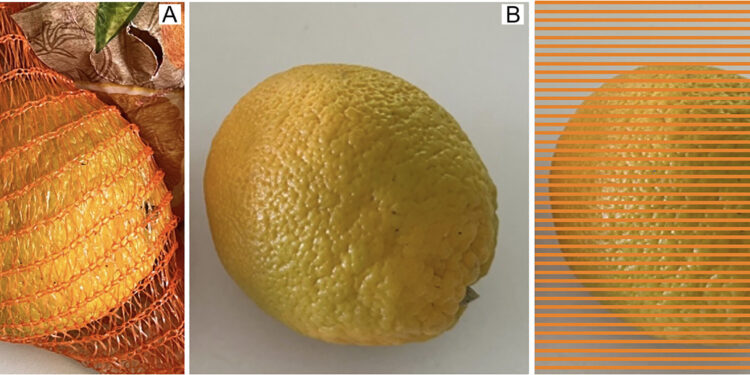Immature green orange (A) in orange net, (B) in isolated view and (C) with a “Munker net”. Credit: i-Perception (2024). DOI: 10.1177/20416695241258748
People who shop at their local supermarket may have noticed that some of the fruit they buy may not look the same at home as it does in the store, or more specifically, out of the box. This is due to something called the “confetti illusion,” in which bits of colored material partially obstructing the view of an image can change the way our brains process its coloring.
Karl Gegenfurtner, a psychologist at the University of Giessen in Germany, has discovered that the “confetti illusion” used by fruit vendors and others to promote their products is due to a perceptual illusion that involves the way our brains are programmed to interpret visual information. In his paper published in the journal i-PerceptionIt describes a brain phenomenon called color assimilation and how it contributes to optical illusions.
Food producers have long learned that if oranges are wrapped in plastic netting, they appear more orange, which gives the mind a more flavorful ripe fruit. The same is true for yellow netting for lemons and green netting for limes. The color of the fruit as seen between the plastic netting is altered by what Gegenfurtner describes as color assimilation.
He felt compelled to take a fresh look at the confetti illusion after experiencing it himself when he came home from the supermarket and discovered that the bright orange appearance of his oranges was noticeably greener once removed from their mesh bag.
Upon reflection, he noted that this could be explained by previous research showing that sensory stimuli are always made up of partial information: the things we see are assembled into images only after the brain has pieced together information from multiple sources. When we look at an ordinary sidewalk, for example, we may perceive different images depending on the ambient temperature, smells like freshly mown grass, or even the residue in our mouth from our last meal.
Version of the confetti illusion with the faces of Helmholtz, Maxwell and Young. Credit: i-Perception (2024). DOI: 10.1177/20416695241258748
By publishing in his paper photos of human faces with colored bars drawn on their faces, Gegenfurtner demonstrates that the change in color of the fruit is not due to the way light reflects off the net. Since the images are 2D, there is no chance that the colors of the bars will be reflected in the image below, but the skin color and complexion of the person behind them appear to change anyway.
More information:
Karl R. Gegenfurtner, Perceptual ripening of oranges, i-Perception (2024). DOI: 10.1177/20416695241258748
© 2024 Science X Network
Quote:Study reveals why orange mesh packaging makes oranges more appealing (2024, August 22) retrieved August 22, 2024 from
This document is subject to copyright. Apart from any fair dealing for the purpose of private study or research, no part may be reproduced without written permission. The content is provided for informational purposes only.



